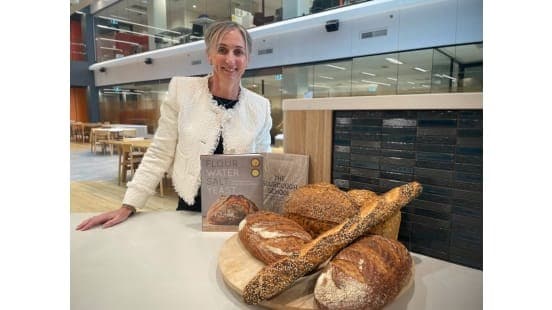New research from UNSW Sydney shows that sourdough may not be the healthiest choice in the bread aisle – unless it’s whole grain.
Sourdough has had a renaissance in Australia in recent years. This has been partly driven by the COVID-19 pandemic and lockdown baking; from March to April 2020, Google searches for sourdough increased by 400 per cent.
The popularity of sourdough can also be attributed to its perceptions about it being healthier, due to a long fermentation process and a small number of additive ingredients.
Researchers Jaimee Hughes and Associate Professor Sara Grafenauer from UNSW Medicine & Health, in new research published in the International Journal of Food Sciences and Nutrition, investigated whether this is the case. They assessed hundreds of Australian bread products to compare the ingredients and nutritional profile of sourdough to other bread types.
The researchers found that despite sourdough’s perceived ‘healthiness’ and traditional baking methods, many sourdough products contained non-traditional added ingredients. In addition, sourdough products were not necessarily more nutritious than others, with the healthiest choices being whole grain breads.
“There are a lot of claims out there in the marketplace that could be distracting for consumers,” says A/Prof. Grafenauer, who is an Accredited Practising Dietitian.
What is sourdough?
Sourdough is both a noun and a verb. It’s the oldest way of leavening bread, using sourdough starter – a live fermented culture of flour and water – rather than baker’s yeast. The fermentation period for the dough is typically longer, ranging from four hours up to 72 hours. The resulting sourdough bread has a characteristically sour taste.
“Sourdough bread should be flour, water, salt and that’s it. You use the leftover dough to create each subsequent loaf,” A/Prof. Grafenauer says.
In some countries, bread products must meet certain requirements to be labelled as sourdough. For example, in France, sourdough bread must contain only flour, water and salt, with a very small quantity of baker’s yeast added at the final stage of kneading.
There is no such regulation in other jurisdictions. In the United Kingdom, craft bakers have established the Real Bread Campaign against ‘sourfaux’ bread sold by supermarket chains and industrial bakeries. The ‘sourfaux’ bread contains many non-traditional ingredients and baking processes but can be legally sold as sourdough.
“Likewise, in Australia there is no guidance on the definition of sourdough,” A/Prof. Grafenauer says.
Supermarket sleuthing
The researchers visited four supermarket chains (Coles, Woolworths, Aldi and IGA) and the Baker’s Delight franchise in Sydney in October 2019 and October 2021. They surveyed all available products in the bread category across the stores – 669 in 2019 and 800 in 2021. The information collected included ingredient lists, nutritional information, and claims on the product packaging.
From October 2019 to 2021, the number of products labelled as sourdough grew from 72 to 108 – a 50 per cent increase. This outstripped the growth of the bread category overall, which was 20 per cent.
Non-traditional ingredients
Surprisingly, the researchers found that 83 per cent of sourdough products contained ingredients not traditionally found in sourdough breads. These included added yeast, emulsifiers, preservatives, and stabilisers.
“You may think that you’ve got a beautiful sourdough bread, but it’s actually got a whole range of other ingredients added to it,” says A/Prof. Grafenauer.
The researchers also found that in 2021, 26 per cent of the sourdough products had claims on the packaging about the sourdough fermentation process. This was an 86% increase from 2019. The researchers did not test the validity of these claims, but according to A/Prof. Grafenauer, the length of the fermentation period for sourdough products is not the most important nutritional quality.
“A big number of claims were related to fermentation, particularly fermentation time ranging from eight hours to 72 hours. Other research has found that you can actually see changes in the bread with as little as four or five hours of fermentation,” says A/Prof. Grafenauer.
Sourdough fermentation has previously been shown to reduce the levels of Fermentable Oligosaccharides, Disaccharides, Monosaccharides and Polyols (FODMAPs) in the bread. This may assist people with Irritable Bowel Syndrome (IBS), whose symptoms are worsened by FODMAPs. However, these nutritional changes are relatively small, and do not require extremely long periods of dough fermentation.
“People might be taken in by claims about long fermentation time thinking: this is real sourdough,” A/Prof. Grafenauer says. “But what they actually need to do is look at the list of ingredients.”
Go for wholemeal
The researchers also assessed the nutritional profiles of the different bread products. These products were considered to be more nutritious if they contained higher levels of protein and dietary fibre, as well as lower levels of sodium.
“Just don’t be taken in by the sourdough health halo,” A/Prof. Grafenauer says.
Whether or not a product was sourdough did not significantly influence its nutritional profile. The more important factor was the type of flour used, with whole grain breads being more nutritious than white breads. This is consistent with recent research showing that there isn’t a particular health advantage to sourdough unless it is whole grain sourdough.
A/Prof. Grafenauer says that understanding how different types of breads stack up nutritionally is important for consumers, especially as sourdough products tend to be more expensive, and many households are trying to get the most bang for their buck at the grocery store.
“If someone is confused about what bread to choose, whole grain is the best choice,” A/Prof. Grafenauer says.
“You can buy a reasonably priced loaf of bread and feel that you are giving your family members the best opportunity in terms of their health.”
By Madeleine Massy-Westropp, UNSW Faculty of Medicine & Health



